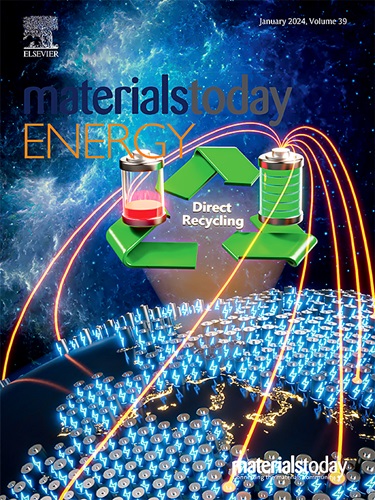Enhancing energy storage performance of polyethylene via passivation with oxygen atoms through C-H vacancy carbonylation
IF 8.6
2区 材料科学
Q1 CHEMISTRY, PHYSICAL
引用次数: 0
Abstract
Low energy density of polymer film capacitors is regarded as one of the most serious drawbacks facing growing demands for equipment integration and miniaturization. Herein, ultraviolet light and ozone (UVO) surface modification is utilized to simultaneously improve dielectric constant and breakdown strength of polyethylene (PE) films. As a result, after 3 minutes of UVO treatment, an enhanced recoverable energy density of 4.79 J/cm with a charge-discharge efficiency of >95% is obtained under 650 MV/m at room temperature (RT). Significantly, stable energy storage performance under 200 MV/m maintains throughout a broad temperature range from -90°C to 90°C and during 20000 cycles of charge-discharge procedures. According to first-principles calculations and thermally stimulated depolarization current measurements, formation of carbonyl groups (C=O) after UVO treatment could effectively passivate initial deep-level defect states caused by H vacancies, which explains the improvement in capacitive energy storage. Moreover, the metalized UVO-modified PE exhibits valuable breakdown self-clearing ability, and the self-cleared specimen maintains stable energy storage performance over 20000 cycles at 200 MV/m and RT. This work offers an effective and user-friendly method for enhancing comprehensive dielectric characteristics of PE-based materials, potential for applications in modern power systems and electronic devices.通过 C-H 空位羰基化用氧原子钝化提高聚乙烯的储能性能
聚合物薄膜电容器的能量密度低是设备集成化和微型化需求日益增长所面临的最严重缺陷之一。本文利用紫外线和臭氧(UVO)表面改性技术同时提高聚乙烯(PE)薄膜的介电常数和击穿强度。结果,在室温(RT)下,经过 3 分钟的紫外线臭氧处理后,在 650 MV/m 的条件下,可回收能量密度达到 4.79 J/cm,充放电效率大于 95%。值得注意的是,在-90°C 至 90°C 的宽温度范围内,以及在 20000 次充放电过程中,200 MV/m 下都能保持稳定的储能性能。根据第一原理计算和热刺激去极化电流测量结果,UVO 处理后形成的羰基(C=O)可有效钝化由 H 空位引起的初始深层次缺陷态,这就是电容储能得到改善的原因。此外,金属化 UVO 改性聚乙烯还表现出宝贵的击穿自清除能力,自清除试样在 200 MV/m 和实时条件下循环 20000 次后仍能保持稳定的储能性能。这项研究为增强聚乙烯基材料的综合介电特性提供了一种有效且易于使用的方法,具有在现代电力系统和电子设备中应用的潜力。
本文章由计算机程序翻译,如有差异,请以英文原文为准。
求助全文
约1分钟内获得全文
求助全文
来源期刊

Materials Today Energy
Materials Science-Materials Science (miscellaneous)
CiteScore
15.10
自引率
7.50%
发文量
291
审稿时长
15 days
期刊介绍:
Materials Today Energy is a multi-disciplinary, rapid-publication journal focused on all aspects of materials for energy.
Materials Today Energy provides a forum for the discussion of high quality research that is helping define the inclusive, growing field of energy materials.
Part of the Materials Today family, Materials Today Energy offers authors rigorous peer review, rapid decisions, and high visibility. The editors welcome comprehensive articles, short communications and reviews on both theoretical and experimental work in relation to energy harvesting, conversion, storage and distribution, on topics including but not limited to:
-Solar energy conversion
-Hydrogen generation
-Photocatalysis
-Thermoelectric materials and devices
-Materials for nuclear energy applications
-Materials for Energy Storage
-Environment protection
-Sustainable and green materials
 求助内容:
求助内容: 应助结果提醒方式:
应助结果提醒方式:


